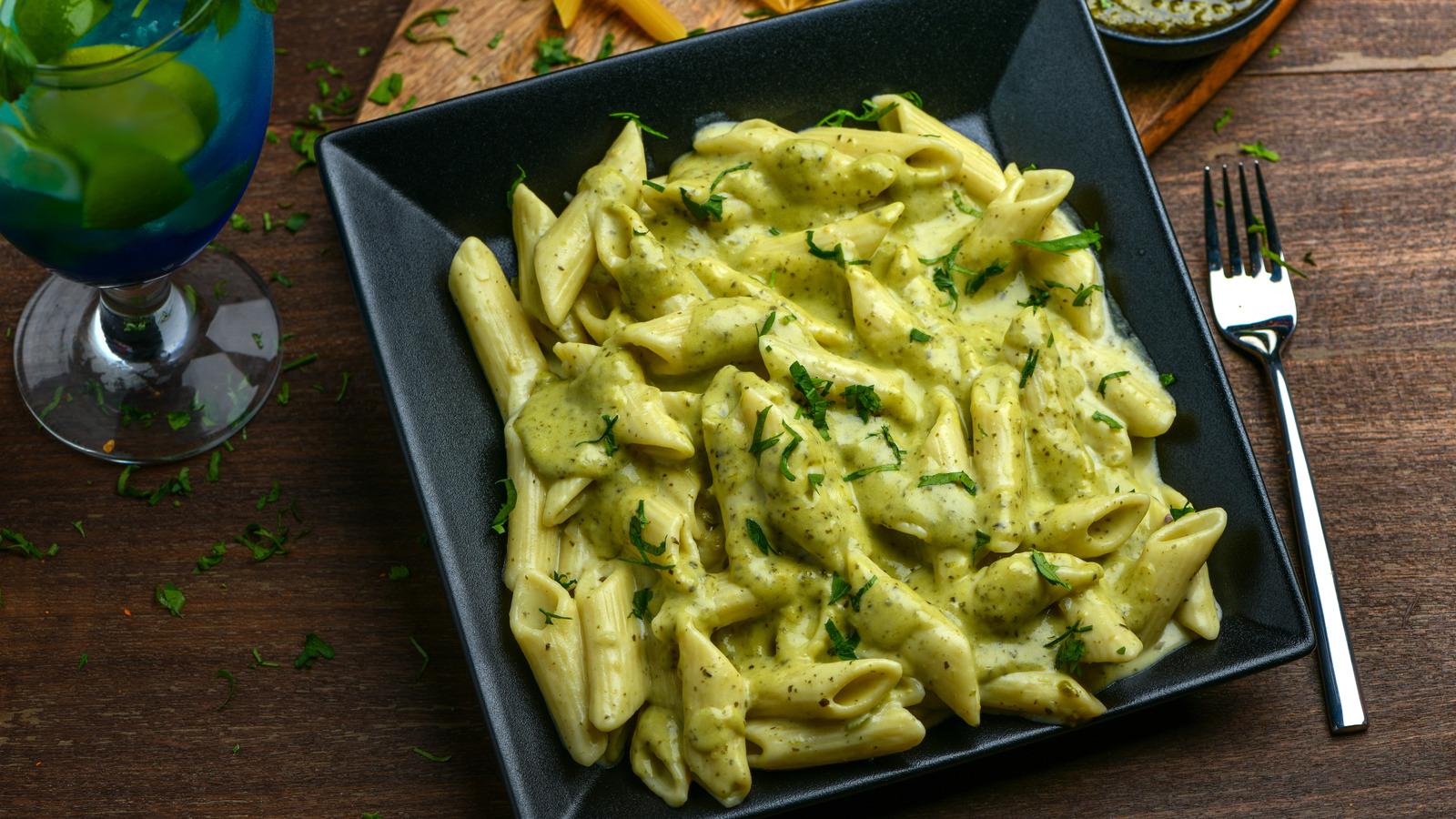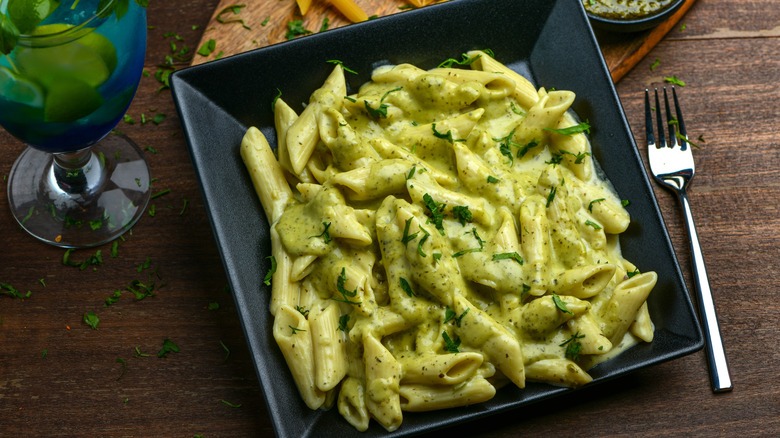
KamarCK/Shutterstock
Pasta is the go-to for so many home cooks because it's fast and versatile. It works for an easy weeknight meal, but you can also dress it up and turn it into a fancy dish. It's great for single servings or large potluck dinners — and even the pickiest eaters almost always like pasta.
To top these dishes, pasta sauces are usually simple to make and easy on the grocery budget (don't worry, we won't tell anyone if you just grab a jar from the store to make meal prep even easier). But if you're getting tired of the same old marinara sauce on your favorite pasta, keep reading, because we've got a list of pasta sauces that you might not be so familiar with.
The truth about marinara sauce is that it's great, of course. But if you don't like tomatoes or just want something different, there are so many other options, ranging from herby to spicy to cheesy. For some inspiration, we went vintage to find sauces that our grandparents kept on their dinner rotation, and ones you might find in neighborhood Italian restaurants that have been around forever. Here are some of the best old-school pasta sauces that you need to try, which can be used in a variety of unique pasta recipes.
Puttanesca
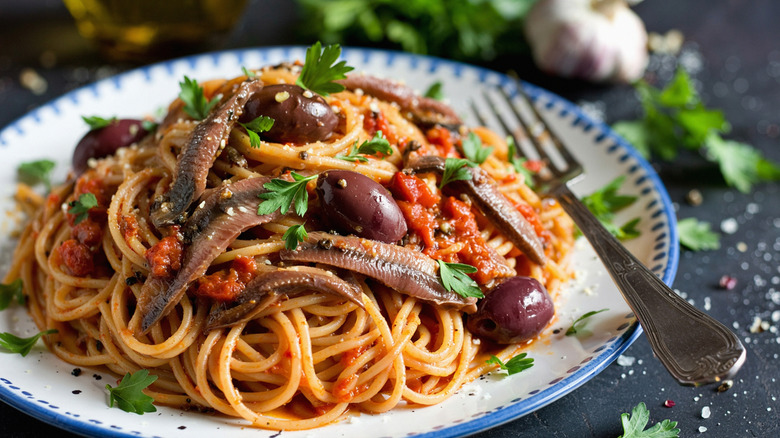
Sophie_Marie/Shutterstock
Puttanesca sauce comes from southern Italy, and its origins probably date back to the 1800s, although the term "puttanesca" wasn't coined until the mid-20th century. The legend of its name is almost as salty as the sauce itself, since "puttana" is Italian slang for "prostitute."
One story has it that a brothel owner in Naples needed a fast meal to serve patrons of the shady establishment. Another version of the tale describes brothel workers looking for an easy-to-make meal between attending to clients. Yet another legend credits Italian restaurant owner Sandro Petti with creating the dish in the 1950s. That version has a group of late-evening customers demanding that Petti cook a meal with the few ingredients that remained on hand, and utilizing the rude slang term in the process. Instead of being offended, Petti created a classic dish on the spot.
A typical puttanesca recipe contains tomatoes, olives, capers, anchovies, and garlic cloves, and is seasoned with red pepper flakes, Italian parsley, and basil. Sauté the garlic, anchovies, olives, and capers in olive oil, then add the tomatoes and let the pasta sauce simmer while the pasta cooks. If you're not a fan of anchovies, chop them up into smaller pieces — but do use them, because this sauce needs their salty goodness.
Traditionally, puttanesca is served with spaghetti, but you can also use other long noodles like linguine or bucatini. And if shorter pasta like penne is what you have on hand, that works, too!
Fra diavolo
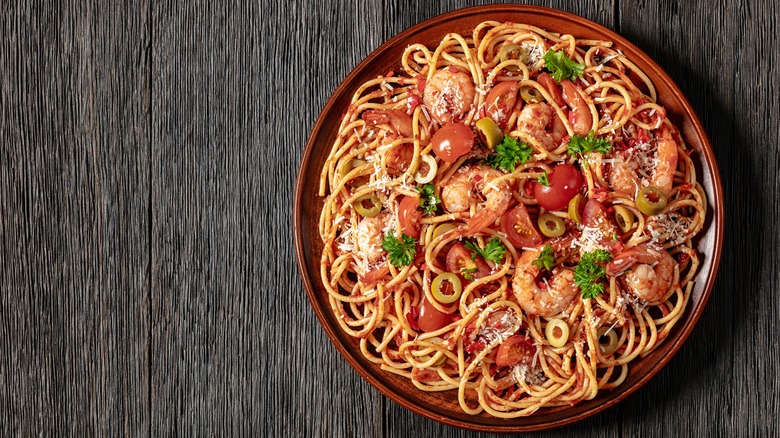
from my point of view/Shutterstock
Another spicily titled pasta sauce has its origins in New York, even though its name is firmly grounded in Italian folklore. Fra diavolo translates to "brother devil" in English; it's also the nickname of an Italian folk hero who fought against the French during the Napoleonic Wars. Michele Pezza earned this alias over the course of his sometimes-devilish career, and now fra diavolo sauce shares a sinister meaning — which is apropos, since it's seasoned with hot chilies.
In spite of what the name implies, fra diavolo sauce was most likely first made in one of New York's Italian restaurants in the early 20th century. It's not clear if that restaurant was on Long Island or in Manhattan, but it definitely wasn't created in Italy.
Fra diavolo sauce is fiery, just like its namesake. The heat comes from Calabrian chili peppers or red pepper flakes, cooked into a fire-roasted tomato base. The other defining ingredient of fra diavolo sauce is seafood. One of the first versions of this dish may have used lobster, but spicy shrimp fra diavolo is a tasty version of this sauce recipe.
Serve fra diavolo with long pasta noodles like linguine or spaghetti. It also works brilliantly in oven-heated pasta dishes like baked ziti, or even as a pizza sauce.
Cacio e pepe
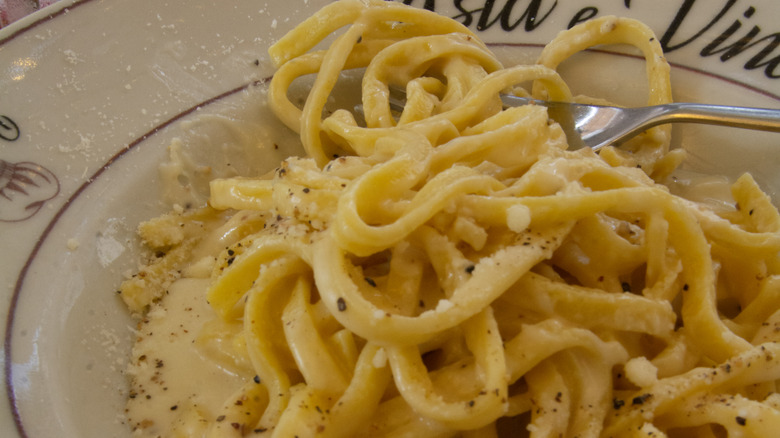
Massi67/Getty Images
Cacio e pepe is a deceptively simple sauce. You might think that it would be easy to make a sauce with only two major components — cacio e pepe literally translates to "cheese and pepper" — but the cacio e pepe recipe relies just as much on technique as it does on quality ingredients.
One of the four classic Roman pasta dishes, cacio e pepe was purportedly created by ancient Roman shepherds from ingredients like aged cheese, black peppercorns, and dried pasta that lasted a long time, which was blended to provide warm, nourishing meals during long treks as their flocks migrated to new pastures.
If you've had cacio e pepe in a restaurant, you might notice that it's a little different than what you taste at home. Some eateries may use butter or even cream to give the sauce its texture, because it's easier to make it that way. But what makes a proper cacio e pepe sauce so creamy is the starchy pasta water. Mix a little bit of the cooking water with the grated cheese to make a loose paste, and then add that paste to a pan with a little more of the starchy water. Finish cooking the pasta in the pan, making sure to coat each noodle with the sauce. Because it's finished with the sauce, the best pasta type for cacio e pepe is spaghetti, but rigatoni or tagliolini work as well.
Pesto alla Genovese
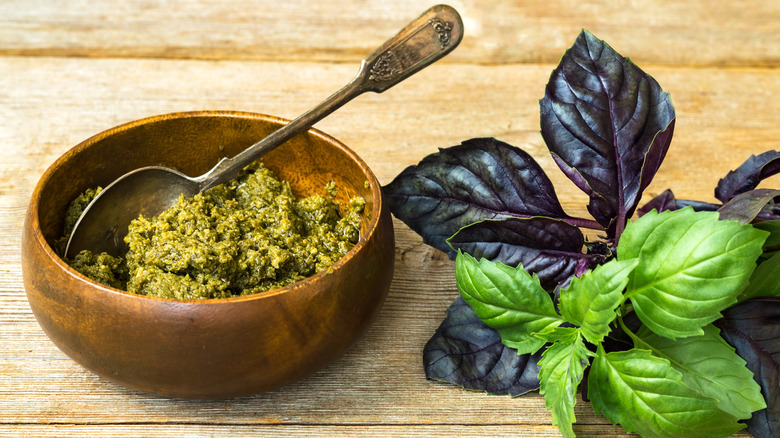
Евгения Матвеец/Getty Images
The first official pesto Genovese recipe was reportedly written down in 1863 by Italian foodie Giovanni Battista Ratto in his cookbook, "La Cuciniera Genovese." What made his recipe different was that it used fresh basil, an herb easily found in the Ligurian region of Italy.
Pesto is a little unusual among pasta sauces, because it is uncooked. The sauce is made by crushing basil, pine nuts, garlic, salt, and cheese in a mortar and pestle (in Italian, the word "pestare" means "to pound," which is how pesto got its name). The paste is then mixed with olive oil.
While the basic recipe remains unchanged, there are a few modernizations to pesto. Some chefs still use the mortar and pestle method, but food processors are just as popular. Traditionalists call for using Parmigiano-Reggiano and pecorino fiore Sardo cheeses, but because the latter (Sardinian sheep-milk cheese) is harder to find, pecorino Romano is often used instead.
You can serve pesto with almost much any kind of pasta, long or short — though it works best on pasta shapes that grab onto the sauce, like gemelli, fusilli, or garganelli. It's also great on bread, pizza, fish, potatoes, and vegetables.
Arrabbiata
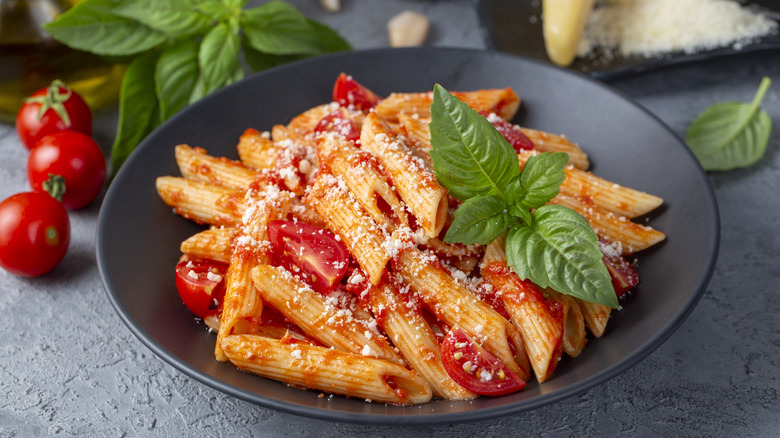
Esin Deniz/Getty Images
Arrabbiata is a spicy, tomato-based sauce that is anything but a marinara derivative. "Arrabbiata" translates into "angry" — and this sauce is spicy enough to make your face turn red, just like when you're angry. It's also a simple sauce to make, using just four ingredients: tomatoes, garlic, olive oil, and crushed red peppers.
The recipe likely comes from the early 20th century. The story goes that a Roman trattoria owner was looking for an alternative to amatriciana sauce, which has guanciale in it. So, he removed the cured pork cheek and added garlic and plenty of red chilies. Italian filmmaker Federico Fellini gave the dish a star turn in his 1972 film, "Roma," cementing arrabbiata sauce in pop culture and food history.
Penne is the traditional pasta shape for arrabbiata sauce, but spaghetti and bucatini work as well. A suggestion for busy pasta fans: arrabbiata sauce freezes beautifully, so make a big batch and put half of it in the freezer for a fast weeknight meal later.
Al nero di seppia
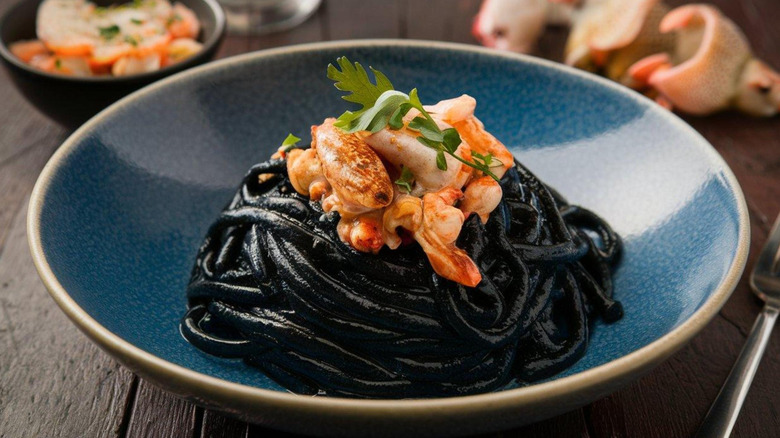
Food magic/Shutterstock
One of the most striking pasta sauces on our list is al nero di seppia. The main ingredient in this sauce might be a little unexpected, unless you're from Sicily, where gifts from the sea are part of everyday life. One common catch for Sicilian fisherman is squid and cuttlefish, both of which contain a black liquid they squirt out to protect themselves from predators. That "ink" turns out to be a salty, delicious substance that Sicilian chefs use to create al nero di seppia.
Squid ink can be used to dye the pasta itself, or be added to the pasta sauce to create an eye-catching black color. If you're making fresh pasta, simply mix the ink into the pasta dough. The traditional sauce recipe involves sautéing garlic, then adding a splash of white wine and the squid ink to bring the sauce together. The pasta is finished in the sauce, and topped with parsley to serve.
Long pasta varieties — like spaghetti, linguine, or tagliatelle — work best with al nero di seppia. It creates a lovely pile of pasta in a bowl, and it's lots of fun to twirl the inky-dark goodness around a fork.
Al limone
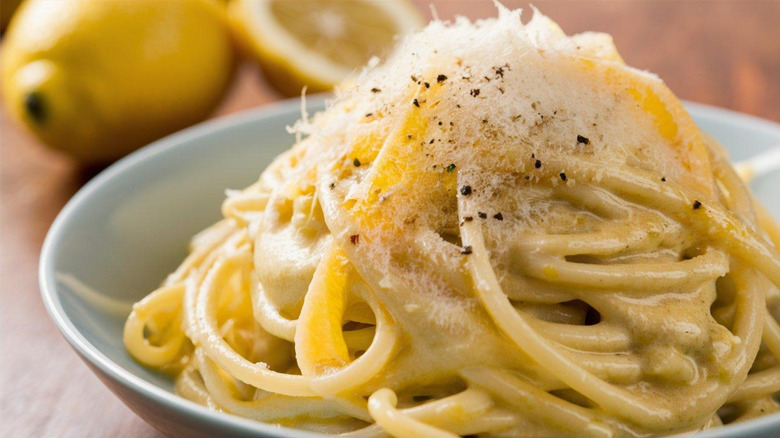
Food magic/Shutterstock
Al limone is so simple to make, and beautifully bright in taste. Technically speaking, you can use any of the many types of lemons, but the most authentic al limone sauce is made with Sorrento or Amalfi lemons, which are grown in the southern Italian region of Campania. This area — particularly the Amalfi Coast and the Sorrento peninsula (lending their names to those particular lemon varieties) — is world-famous for its lemons. So, it's probably no surprise that Campania's chefs were the first to create this delightful lemon-based pasta sauce.
The sauce starts with butter, infused with lemon zest and garlic. Some of the cooking water from the pasta is added to the butter, before grated Parmigiano-Reggiano cheese and lemon juice are stirred in. Some versions of al limone use heavy cream to enhance the texture, but as with cacio e pepe, this version is not traditional. Plus, dairy can actually diminish the lemon flavor, so if you want the full al limone experience, try it without cream first.
Serve al limone sauce over long noodles like spaghetti or linguine; farfalle can be nice for this dish, too. Top with freshly-ground black pepper and more cheese. Here's a tip: Make this sauce in the middle of winter, when you really need a sunshiny-bright dish to chase away the cold.
Salsa di noci
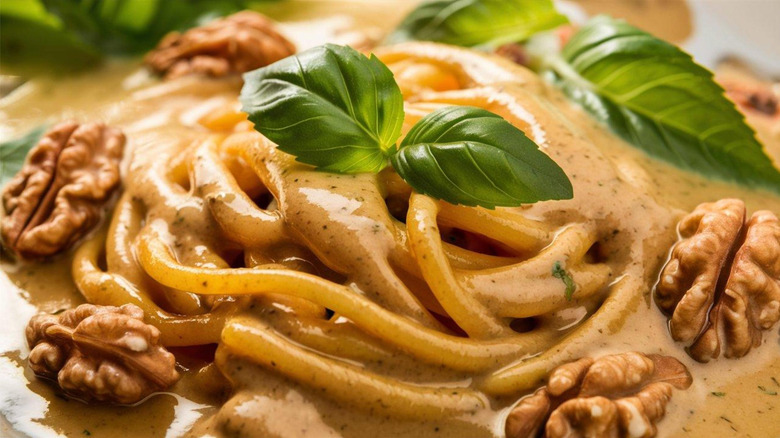
Food magic/Shutterstock
You might think of salsa di noci as pesto's lesser-known cousin, but this Ligurian sauce purportedly predates basil-based pesto by at least 300 years. The original recipe can be traced back to cookbooks from the 16th century, and while it may not be as widely known today as basil pesto, it's definitely worth trying — especially if you've learned the reason why you should be eating walnuts every day.
Salsa di noci is an uncooked sauce made with walnuts, pine nuts, grated Parmesan cheese, garlic, fresh marjoram, and olive oil; it is thickened with milk and white bread. While using a mortar and pestle is the traditional way of making the sauce, a food processor works perfectly for a modern version. Before you throw everything into the food processor, soak the bread in the milk. Once the bread is drenched, place it in the food processor with the other ingredients, but reserve the excess milk. Use it to thin the sauce if needed.
You can use long or short pasta shapes for this dish. Trofie, which has a short, twisted shape, is a traditional pasta used with this sauce – but salsa di noci is also served over stuffed pasta varieties. This sauce is also lovely on lamb, chicken, and roasted onions. And if you like the sauce a little thicker, you can also serve it as a dip or on crostini.
Scarpariello
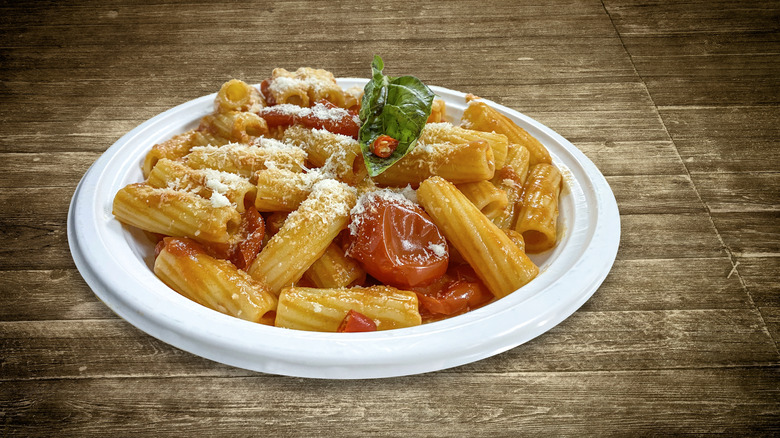
gigadesign/Shutterstock
Scarpariello is a pasta sauce made from ingenuity and leftovers. It was created by cobblers in Naples — "scarparo" meaning cobbler in the Neopolitan dialect — out of leftover tomato sauce, fresh basil, and cheese that customers sometimes offered to barter for shoe-mending work.
Modern versions of scarpariello sauce often use fresh cherry tomatoes instead of leftover red sauce. You can also use small yellow tomatoes for a slightly sweeter sauce, and you can add sausage for a meaty twist. The trick to this sauce is not to overcook it — sauté the fresh tomatoes for only a few minutes, just enough to soften them. Then add grated Parmesan and pecorino Romano cheese to the tomatoes, toss the pasta in to finish cooking, and top with a few basil leaves to enjoy this meal.
You can use different types of pasta with scarpariello sauce. Long noodles like bucatini or spaghetti work well, or you can serve the sauce with penne.
(Fun fact: If you search for scarpariello online, you might stumble upon a chicken scarpariello recipe. But the two dishes are largely unrelated — in fact, the chicken version is considered as an Americanized version of Italian cooking.)
Gorgonzola sauce
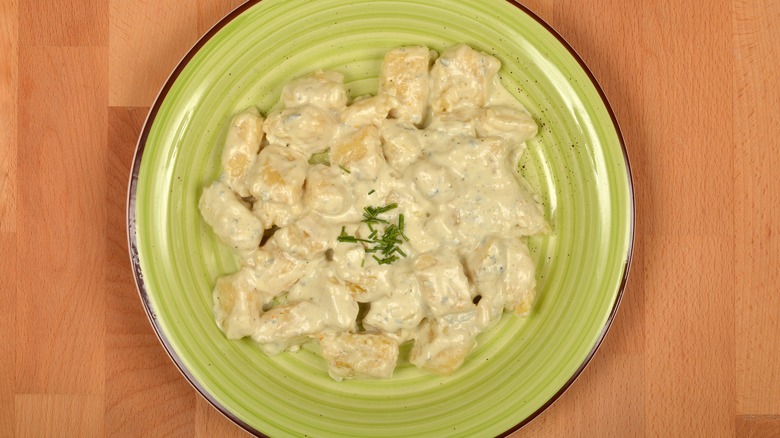
Nahhana/Shutterstock
Tangy Gorgonzola cheese is the foundation of this versatile cream sauce. It's thought that this sauce was first made in the Lombardy region of Italy, which is home to the town of Gorgonzola, where the cheese gets its name. You might know Gorgonzola cheese as a specific type of blue cheese. It's said that this cheese dates back to the Middle Ages. Since 1951, Gorgonzola has been a protected product of its native region, and in 1996 it was registered by the European Union with DOP (Protected Designation of Origin) status. Gorgonzola comes in two varieties, dolce and piccante. Dolce tastes sweeter and milder, with a creamier texture. Piccante is firm, with a much stronger taste.
Making Gorgonzola sauce is similar to other cheese sauces. First melt the butter and add garlic and heavy cream (or a mix of heavy cream and milk), and then melt in the cheese before seasoning the sauce with salt and pepper. The dolce Gorgonzola is what most cooks use for this recipe because it's milder, and the texture makes for a creamy sauce.
Gorgonzola sauce can be served over a variety of pasta shapes, including penne, rigatoni, and longer pasta like spaghetti. You can also use it with gnocchi or gnudi dumplings, or slather it on grilled chicken or pork chops. Furthermore, this cheese can be a perfect choice to create a copycat Olive Garden steak Gorgonzola Alfredo recipe.
Vongole
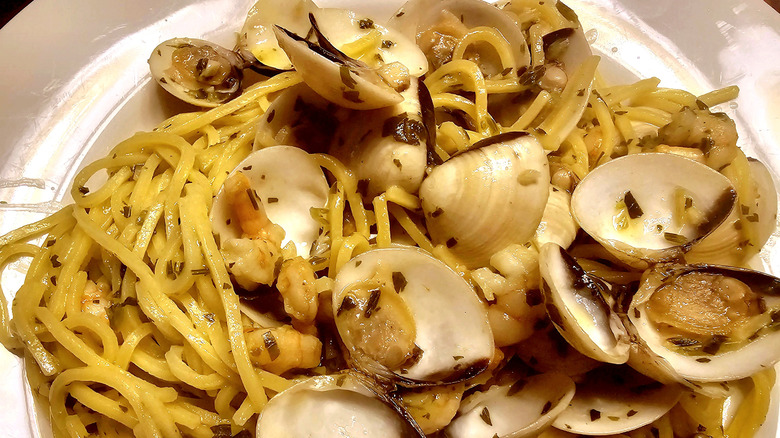
©daniela White Images/Getty Images
Vongole is considered a quintessential dish of Naples. The recipe was supposedly first recorded in 1839 by Ippolito Cavalcanti, the Duke of Buonvicino, in his cookbook, "Theoretical-practical Cuisine." Modern versions of this recipe follow essentially the same steps: steam the clams until they open, add garlic and other seasonings, and finish cooking the pasta in the clam broth, mixing in the mollusks while they're still in their shells.
Traditionally, the clams used in this dish are "vongole veraci," which translates to "true clams." These are small, oval clams found in the waters off southern Italy, treasured because the small bits of clam meat are packed with a briny-but-sweet flavor. But vongole veraci are overfished, so in Italy you may find other Mediterranean clams in the dish. Outside of Italy, you can use any small clam, such as Manila or cockles.
The type of clams used isn't the only tweak that's been made to the original recipe. An early version called for using vermicelli pasta, but today many cooks use spaghetti. Some styles of it include a little lemon juice or Calabrian chilies to give the dish some flair. Others will stick to the original recipe, sprinkling only some chopped parsley over the top (but never cheese). And other cooks prefer to scoop the clam meat out of the shells after they're cooked, leaving only a few shells as a garnish. However you decide to fix it, vongole is the perfect mix of seafood and pasta.



